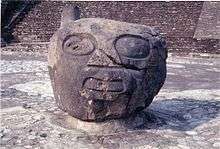
Cholula (Mesoamerican site)
Cholula (Nahuatl: Cholōllān) (Spanish  ), was an important city of pre-Columbian Mesoamerica, dating back to at least the 2nd century BC, with settlement as a village going back at least some thousand years earlier. The great site of Cholula stands just west of the modern city of Puebla and served as a trading outpost. Its immense pyramid is the largest such structure in the Americas, and the largest pyramid structure by volume in the world.
), was an important city of pre-Columbian Mesoamerica, dating back to at least the 2nd century BC, with settlement as a village going back at least some thousand years earlier. The great site of Cholula stands just west of the modern city of Puebla and served as a trading outpost. Its immense pyramid is the largest such structure in the Americas, and the largest pyramid structure by volume in the world.
Location and environment
It is located in the Puebla-Tlaxcala Valley of the central Mexican highlands. It is surrounded to the west by the snow-covered peaks Popocatepetl and Iztaccihuatl, and Malinche to the north. The summer rainy season and the melted snow in winter provide a great environment for irrigation agriculture. There is also a confluence of several perennial streams with the Atoyac River that creates a wetland to the north and east of the urban center. This has resulted in abundant and excellent agriculture during the colonial period, which lead to Cholula being known as the richest agricultural region in central Mexico. Maize is the major crop cultivated but they also harvested maguey, chiles, and cochineal for dye. The soil is rich in clay, which made pottery and brick-making an important part of their economy. Textiles and elaborate decorative capes were also popular.
 The Galveston Daily News
22 Apr 2025
The Galveston Daily News
22 Apr 2025
 The Galveston Daily News
22 Apr 2025
The Galveston Daily News
22 Apr 2025


